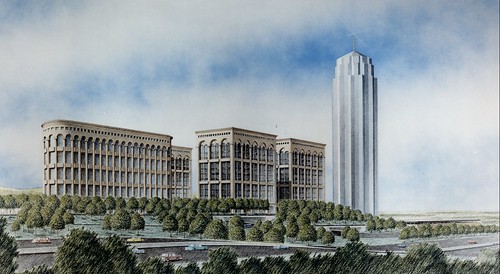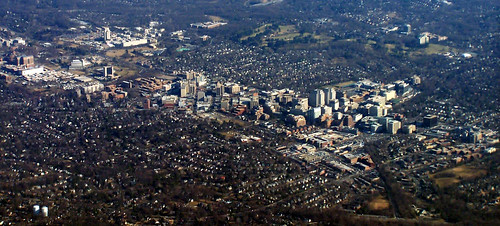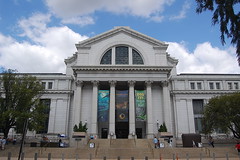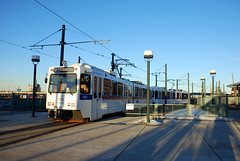Look at this interesting bike box from Milton Keynes, UK. It’s on a street that doesn’t have a bike lane, where cyclists therefore run in mixed traffic with cars. The protruding section appears to provide cyclists with a safe way to jump ahead of cars queued at the red light.

Image from Google Street View.
In the US, bike boxes are usually placed on streets with bike lanes or cycletracks. It’s unusual to see one on its own.
Milton Keynes is a large 1960s-era new town. It’s the UK’s equivalent to Columbia, MD or Reston, VA. Except Milton Keynes is larger, with around 200, 000 residents.
Average Rating: 4.7 out of 5 based on 164 user reviews.
August 13th, 2013 | Permalink
Tags: bike, transportation
Workers are officially in the field, starting to build Phase 2 of the Silver Line.
Phase 1, from East Falls Church on the Orange Line through Tysons Corner and ending at Wiehle Avenue, is near completion and is expected to open early in 2014. Phase 2 extends west from Wiehle to Dulles Airport and into Loudoun County.
Construction crews were given a notice to proceed in July, and as of today they’re at Dulles Airport doing survey work.

Map of Phase 2. From the Dulles Corridor Metrorail project.
Average Rating: 4.7 out of 5 based on 183 user reviews.
August 12th, 2013 | Permalink
Tags: metrorail, transportation
National Harbor was originally going to be called Port America, and it almost included a skyscraper that might have been taller than the Washington Monument.
By 2008 when the first part of National Harbor opened, the concept of suburban town centers was tried and true. But developers have been trying to build a town center there since the mid 1980s. When they started, it was the most progressive of ideas.
The original plan for Port America dates from 1987. It would have included a neo-classical mixed-use town center in the same place as National Harbor’s waterfront, plus a large office park on the adjacent property that is now under-construction to become an outlet mall.
The office park would have included a 52-story trophy office tower. It would very likely have risen above the 555-foot Washington Monument, and definitely would have dwarfed the DC region’s current tallest office building, Rosslyn’s 384-foot 1812 North Moore.
 |
 |
 |
 |
| Port America. All images from Burgee-Jonhson. |
 Cross-posted at Greater Greater Washington.
Cross-posted at Greater Greater Washington.
Average Rating: 5 out of 5 based on 161 user reviews.
August 9th, 2013 | Permalink
Tags: development, history, urbandesign
Downtown Bethesda has a pretty impressive central clump of buildings, no?
In this picture Wisconsin Avenue runs from left (north) to right (south).

Photo from a plane window. It’s a couple of years old, but I just found it on my hard drive.
Average Rating: 4.4 out of 5 based on 216 user reviews.
August 8th, 2013 | Permalink
Tags: galleries
|

This doesn’t make money either.
Photo by \Ryan on flickr. |
Why do cities keep building stadiums, despite study after study showing they don’t make money? Simple: They’re cultural amenities that people want, and are willing to pay for.
When Mayor Gray announced the DC United stadium deal last month, he kicked off a public debate about stadium-building. Much of the debate has focused on whether or not the deal will make DC any money.
The fact that stadiums often lose money is largely irrelevant. So do museums, libraries, and opera houses. Stadiums fall into the same category.
Smart communities try to squeeze some economic development out of stadium deals, because they may as well, but that’s always a side benefit. At the end of the day it isn’t the main reason cities build stadiums.
It’s true that the privately-owned sports franchises that use stadiums reap a disproportionate benefit from public financing deals, but that’s also irrelevant to the stadium-building decision. Pro sports franchises are also cultural amenities that lots of people want and will pay for.
This is why decades of policy wonk hand-wringing over the money has rarely convinced anyone to stop building stadiums. That criticism, true as it is, simply does not invalidate the perceived benefit.
 Cross-posted at Greater Greater Washington.
Cross-posted at Greater Greater Washington.
Average Rating: 5 out of 5 based on 187 user reviews.
August 6th, 2013 | Permalink
Tags: development, economy, government
|

Denver is expanding its light rail system using private partners. |
Maryland Governor O’Malley is expected to announce today that the federal government has approved the Purple Line’s planning, and that Maryland will seek a private company to help pay for construction.
The idea is that a private company would pool its money together with state and federal funding to construct the Purple Line. The same company would then operate the line. In exchange, they would keep the fares, and Maryland would pay an annual contract fee.
With limited federal funds available, this type of public-private partnership is becoming common nationwide. DC is considering it for streetcars, but Denver offers a more instructive example.
In 2004, voters in Colorado passed a referendum for 122 miles of new rail transit in the Denver area. But the funding approved as part of that vote wasn’t adequate to build everything, so the transit agency had to find an alternate strategy. They’ve since approved two public-private partnerships, and are in the process of contracting a third.
Denver’s first partnership was for the Eagle P3 project, which is building 40 miles of electric commuter rail to the Denver suburbs and airport, at a cost of about $2 billion. The partnership is proceeding smoothly, with construction well underway and completion expected in 2016.
The second partnership is for a 10-mile-long suburban light rail extension. It began construction last year and is also expected to open in 2016.
The third will be for the 18-mile North commuter line. The transit agency put out a Request For Proposals in June, and is expected to select a partner company this fall.
All in all, Denver has or will soon have private partnerships to build almost 70 miles of new rail.
These deals do come with a cost. Typically the annual fee the state has to pay the partner is higher than the typical operating subsidy would be. So in essence, the operating cost is higher. But in exchange, the partner builds the line more quickly and sometimes more cheaply than the government could on its own.
Update: As expected, O’Malley announced the plan to use a partnership this afternoon. He also announced $680 million in state funds for the Purple Line, plus millions more for the Corridor Cities Transitway, Montgomery County Ride-On, and road projects.
Average Rating: 4.9 out of 5 based on 231 user reviews.
August 5th, 2013 | Permalink
Tags: commuterrail, funding, government, lightrail, transportation
…Obviously, if you are looking at this.
Here’s what happened: Someone modified BeyondDC to display spam links leading to predatory financial webpages. The website had to be locked for a while in order to clean out the infected code.
Average Rating: 4.4 out of 5 based on 244 user reviews.
August 4th, 2013 | Permalink
Tags: site























